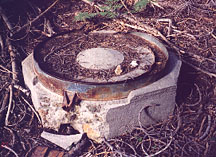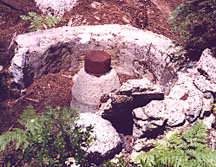|
Quoted from an article by
Ron Cooke
Plumas County Adventures
Ron's Home Page
His Arrastra Page
We frequently investigate gold mines from the 1800's. One
style of mining is known as "Quartz Mining." The gold
(usually small amounts) is contained in quartz veins and the
quartz is underground. Because of this, these mines have tunnels
to get to the quartz and some sort of equipment to break the
quartz to a powder so the gold can be removed.
The usual equipment is a stamp mill--We have found four of these
in our travels. Heavy pieces of steel are lifted vertically by a
cam and then suddenly dropped. The stamp "feet" land
on the ore and crush it. Any book on mining or gold rush history
will have information on stamp mills. You can see a stamp mill
at a rest stop on California State Route 70 at Belden (between
Oroville and Quincy).
Stamp mills weigh many tons and require a large amount of power
to drive them. They are found at the large mines that are fairly
close to main roads.
What about the small mines that are located far from main roads?
What did the small fry miner use to break up the quartz? Most
used some sort of grinder that could be assembled at the site
and powered by water or even by animals.
On three adventures to quartz mines We found devices that can
best be described as crude grinders. In different ways each of
these can be likened to the mortar part of a mortar and pestle.
Lets look at these "mortars."
The first is about three feet in diameter. It is constructed of
concrete and steel and has a spout that the ground material
could exit from. There was no indication of what the driving
power was.

The second one is also about three feet in diameter (as you can
see, much is missing). It is constructed of concrete and stone.
It has a center post so the pestle part must have looked like a
doughnut. There was a badly decomposed 6 foot water wheel nearby
and there was a ditch about 150 feet above the site that would
have provided water power.

The third is very crude. It is 10-12 feet in diameter and made
of posts buried in the ground in a circular fashion. About half
the posts are missing as seen in the poor photo below. The
bottom was rock lined. There was a ditch in the vicinity that
would have provided water. Compare this description to that of
the "Mexican Rastra" found below.

We did some research and found a bit of information about these
crude gold grinders. The best information is from Hutchings and
Rosenfield.1858. "The Miner's Own Book." San Francisco
and is quoted below:
One of the first used, as well as one of the most useful and
most important, is the Mexican Rastra, which is commonly
spelled Arastra. Though rude in its construction and simple in
its working, it is one of the most effectual methods of saving
the gold which has yet been discovered. The Mexican method of
constructing these is to lay a circular track of stone
tolerably level, with a low wall around the outside of the
track; and in the center a post made of a tree cut off at the
required height, and generally just above a crotch or arm;
another small tree is then cut in the shape required, for
making a horizontal shaft; to this is attached one or more
large stones; and these being drawn around by donkey or
mule-power, grind the quartz to powder. Of course, as gold is
the heaviest it naturally seeks the lowest places, and as
quicksilver is always put in with the quartz the gold becomes
amalgamated with it.

The Mexican rastra has been improved some little in its
construction and adaptation to our wants; and in many cases
mule-power has been superseded by steam; but the principle
remains about the same.
When the rastra is properly prepared, a "batch" of
about five hundred pounds is generally emptied into one about
ten feet in diameter; but the quantity is always regulated by
the size of the machine. It is then ground very fine by means
of the drag-stones attached to arms fixed in the perpendicular
shaft, and which are generally given about eight revolutions
per minute. At this rate it will require from three to four
hours to grind the batch sufficiently; but this is somewhat
regulated by the grit and weight of the drag-stones. About
three quarters of an hour before the whole is thoroughly
ground, a sufficient quantity of quicksilver is added; but the
amount is regulated by the richness of the quartz in process
of grinding. If, for instance, the five hundred pounds of
tailings placed in the rastra is supposed to contain about
three quarters of an ounce of gold, about one ounce of
quicksilver is generally used--or about twenty-five per cent
more of the latter than the former. Some judgment is required
in this--too much quicksilver being a disadvantage, inasmuch
as the amalgam should be kept hard to make it effectual in
saving the gold.
Quicksilver should also be kept very free from grease, as it
cannot be too clean, and should invariably be well retorted
every time it is used.
About ten minutes before the grinding is finished, about
sixteen buckets of water are poured into the rastra, to the
quantity named, and the same motion continued, the whole
appearing like muddy water. This is then bailed out, or run
off quickly. Five hundred pounds more of the quartz are then
added, and the process repeated, adding the same portion of
quicksilver to every batch.
This is kept on for one, two, three, or even four weeks,
according to the richness of the quartz, or the taste and
wants of the owner. The larger the amount contained in the
rastra, the more gold is there saved, in proportion, to the
ton.
The amalgam is then taken out of the crevices in the bottom of
the rastra, and carefully panned out, and as carefully
retorted. After this, most business men melt the gold into
bars or ingots, before sending it to the mint to be coined.
Before commencing to grind again, the crevices between the
stones covering the floor of the rastra, about one and a half
inches wide, are tightly packed and filled with clay, level
with the stone.
This mill as used in Chili, and from whence its origin and
name are derived, is nearly as simple in its construction as
the rastra, with the walls a little higher, and more regular;
and, instead of the "drag stones," a large stone
wheel, attached to the horizontal shaft, is used for grinding
the rock. Into this mill a small stream of water is constantly
running, a portion of which is forced out at each revolution
of the wheel. The gold is saved by means of quicksilver on the
bottom of the mill, in the same manner as in the rastra.
To make this principle more subservient to the purposes of
quartz mining, and better adapted the requirements of a faster
age and people, the "improved Chili Mill" was
invented. This consists of two heavy cast-iron wheels, from
three to five feet in diameter, and from ten to fifteen inches
in thickness: these revolve on an axle, moving steadily round
in a circular iron basin about 3 foot in depth, into which the
tailings from the blanket tables are conveyed, and ground to
powder.
As these improved mills are generally worked by steam, the
speed attained, and the work accomplished, of course very far
exceeds the old process.
The methods of saving the gold which passes over the blankets
in the tailings, are almost as numerous as the mills where the
quartz is crushed. The principal, however, is to allow the
tailings to run down a series of inclined tables, or sluices,
at the end of each of which is often placed a wood trough, or
iron pan, containing quicksilver, into which they flow, when
the gold falls into the quicksilver on the bottom, and is
there retained; while the light material floats over the edge
of the trough or pan into another sluice, at the end of which
is another pan, where the same process is repeated. Thee
sluices, or inclined tables, are generally fitted up with
"patent riffles" across the bottom, filled with
quicksilver. After the tailings have passed through the whole
series of sluices they are sometimes: worked through the
improved Chili Mill, or other machine; but are oftener allowed
to run into a large vat, from which the water flows off while
the tailings settle at the bottom. These are then thrown into
a heap and allowed to "rust," preparatory to other
processes at some future time.
Other information comes from Websters
Unabridged Dictionary:
arrastra same as arrastre: [Spanish arrastrar, to drag along
the ground; L, ad, to, and radere, to scrape.] in gold mining,
a crude machine formerly used for ore crushing.
|